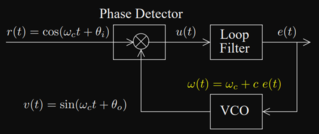Edited, memorised or added to reading queue
on 03-Jan-2024 (Wed)
Do you want BuboFlash to help you learning these things? Click here to log in or create user.
| status | not read | reprioritisations | ||
|---|---|---|---|---|
| last reprioritisation on | suggested re-reading day | |||
| started reading on | finished reading on |
Flashcard 7609145494796
| status | not learned | measured difficulty | 37% [default] | last interval [days] | |||
|---|---|---|---|---|---|---|---|
| repetition number in this series | 0 | memorised on | scheduled repetition | ||||
| scheduled repetition interval | last repetition or drill |
频率调制信号公式
The function of the Frequency Modulating signal is: \(s_{fm}(t)=A\cos(2\pi f_{i}t)\) and the \(f_{i}\) is the instantaneous frequency of a VCO-generated FM signal: \(f_{i}=f_{c}+k_{f}\cdot m(t)\) where \(f_{c}\) is the carrier frequency, \(k_{f}\) is the VCO gain (or the frequency sensitivity factor) measured in Hz/V and \(m(t)\) is the message signal.
| status | not read | reprioritisations | ||
|---|---|---|---|---|
| last reprioritisation on | suggested re-reading day | |||
| started reading on | finished reading on |
Flashcard 7609149689100
| status | not learned | measured difficulty | 37% [default] | last interval [days] | |||
|---|---|---|---|---|---|---|---|
| repetition number in this series | 0 | memorised on | scheduled repetition | ||||
| scheduled repetition interval | last repetition or drill |
频率调制信号的最大偏移比率
The deviation ratio is given by: \(R_{d} = \frac{f_{d}}{B_{m}}=\frac{k_{f}|m(t)|_{\max}}{B_{m}}\) where \(B_{m}\) is the bandwidth of the message \(m(t)\).
| status | not read | reprioritisations | ||
|---|---|---|---|---|
| last reprioritisation on | suggested re-reading day | |||
| started reading on | finished reading on |
Flashcard 7609153883404
| status | not learned | measured difficulty | 37% [default] | last interval [days] | |||
|---|---|---|---|---|---|---|---|
| repetition number in this series | 0 | memorised on | scheduled repetition | ||||
| scheduled repetition interval | last repetition or drill |
频率调制信号的大致带宽公式
The approximate bandwidth of FM signal is: \(B_{FM} = 2B_{m}(1 + R_{d})= 2(B_{m} + f_{d})\). (乘以2是因为频率调制信号一般包含了上下两个侧边带)
| status | not read | reprioritisations | ||
|---|---|---|---|---|
| last reprioritisation on | suggested re-reading day | |||
| started reading on | finished reading on |
Flashcard 7609158601996
| status | not learned | measured difficulty | 37% [default] | last interval [days] | |||
|---|---|---|---|---|---|---|---|
| repetition number in this series | 0 | memorised on | scheduled repetition | ||||
| scheduled repetition interval | last repetition or drill |
相位锁定环描述
相位锁定环描述:相位锁定环是一种通信技术,输入一个之前经过幅度调制的接收信号,输出一个频率相同的正弦振荡信号。其原理根本上来说就是通过不断减小接收信号和本地振荡器信号之间的相位差,使得本地振荡器信号的频率不断逼近接收信号的频率.
Flashcard 7609160699148
| status | not learned | measured difficulty | 37% [default] | last interval [days] | |||
|---|---|---|---|---|---|---|---|
| repetition number in this series | 0 | memorised on | scheduled repetition | ||||
| scheduled repetition interval | last repetition or drill |
